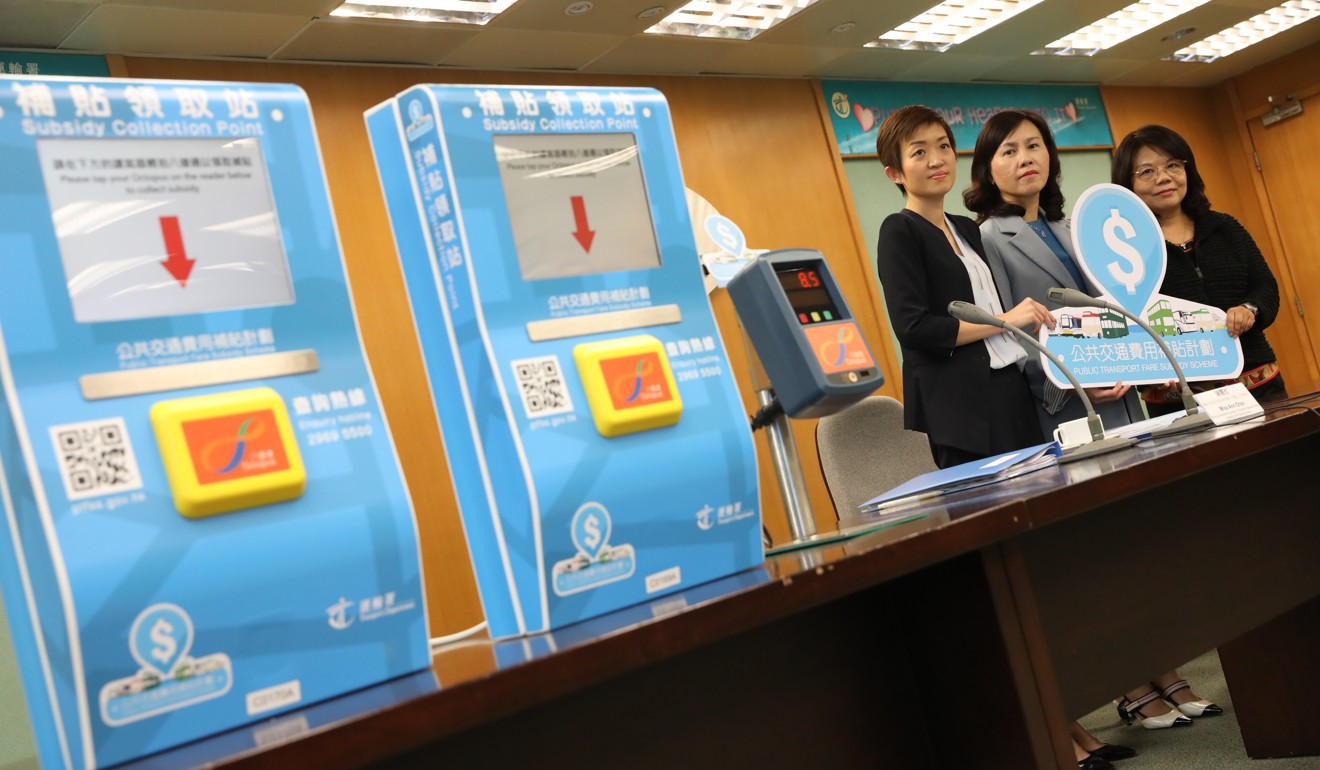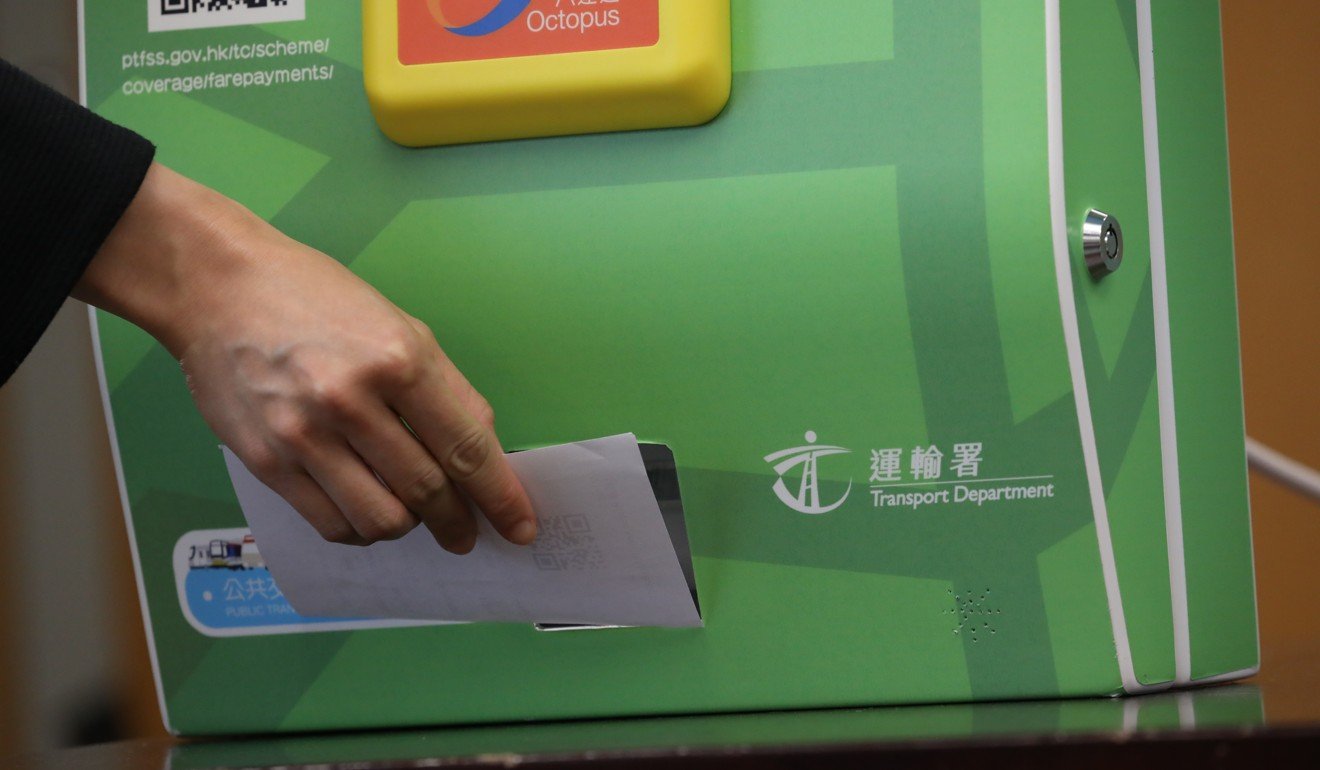
Public transport subsidy for Hong Kong commuters to start from January with government opting to ‘keep it simple’ and not means tested
- Users will receive a 25 per cent discount of their public transport costs beyond the initial HK$400
- Scheme is open to all with subsidies claimed either by Octopus card or mobile app
Hong Kong’s commuters will start benefiting from a non-means tested transport subsidy at the start of next year, the Transport Department has announced.
In a press briefing on Thursday, Commissioner for Transport Mable Chan admitted the government had considered tweaking the scheme to exclude parallel traders, but finally decided to “keep it simple”.
The Transport Fare Subsidy Scheme was first announced last year in Chief Executive Carrie Lam Cheng Yuet-ngor’s maiden policy address as a relieve measure for commuters.
Unlike other existing transport subsidies, the new scheme is not means-tested.

Hongkongers will soon be able to use phones in place of Octopus cards
It will cover all modes of public transport, including the MTR, franchised buses, minibuses, ferries, trams and kaitos – small ferries that serve mainly residents of outlying islands. Monthly bus and MTR passes will also be covered by the scheme.
Chan announced the scheme would come into force on January 1 and that commuters would be able to claim their first subsidy with their Octopus cards from February 16.
Under the scheme, the government is to subsidise 25 per cent of people’s spending on public transport after the initial HK$400 (US$51).
For instance, a commuter who spends HK$1,200 on transport in a particular month will get HK$200 in subsidy.
The subsidy amount is capped at HK$300 per month.
The government estimated the scheme could benefit 2.2 million citizens, costing HK$2.3 billion per year to run.

To claim the subsidy, commuters have to connect their Octopus cards at dedicated readers, which will be placed in MTR stations, Light Rail customer service centres, 7-Eleven and Circle K outlets, and Wellcome supermarkets.
Alternatively, commuters can collect the subsidy via a mobile app, the department said.
The subsidy for a particular month will be available to claim on the 16th day of the following month, and will be valid for three months.
Kowloon Motor Bus said it welcomes the subsidy scheme and hope dedicated readers can also be installed at bus terminals.
Hong Kong slow to go cashless? Blame success of Octopus card, minister says
Lawmakers earlier questioned whether the scheme would be abused by parallel traders, who bring goods from the city centre of Hong Kong to the mainland Chinese border via public transport such as the MTR or buses.
If we had to avoid parallel traders using the scheme, or make additional requirements, it would go against the original intention of the policy
Chan said on Thursday the government had decided to keep the scheme simple, to benefit the greatest number of commuters.
“We figured that if we had to avoid parallel traders using the scheme, or if we had to make additional requirements for people to use the scheme, it would go against the original intention of the policy,” Chan said.
She also disclosed that about 30 operators of public transport, some of which had not previously accepted payment by Octopus card, had joined the scheme.
These operators would be required to obtain approval from the Transport Department and share their transaction records, Chan said.
Civic Party legislator Jeremy Tam Man-ho said it would be hard to for daily commuters to make full use of the subsidy.
Tam said his assistant, who lives in Tin Shui Wai in the New Territories and works in Admiralty on Hong Kong Island, would only receive about HK$140 per month, despite travelling long distances on his daily commutes.
“It means that those who will benefit most might not be normal commuters. It could be parallel traders or people who are always on the move on their job,” Tam said.
He also said the government could consider adjusting the HK$400 threshold to benefit more people, while lowering the subsidy amount so as to maintain the government’s expenditure on the scheme.
Pro-Beijing lawmaker Ben Chan Han-pan, who chairs the Legislative Council’s transport panel, also recommended lowering the HK$400 threshold.
“I hope the government can review it in a year’s time and reduce the threshold to HK$200. People such as housewives might not spend as much as HK$400 a month on transport,” Chan said.


